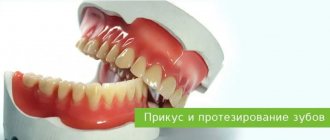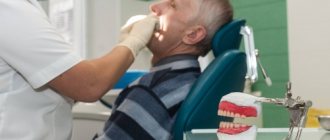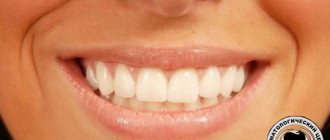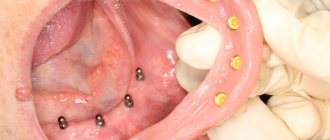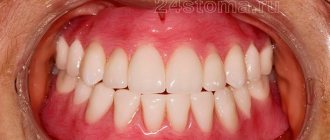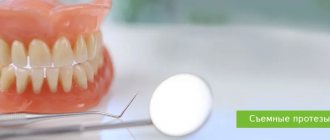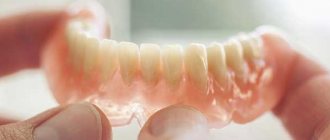Restoring the integrity of the elements of the dentition involves a whole range of measures. If the attending dentist has decided to install a prosthesis using abutment teeth, they will have to be carefully processed first. It should be understood that grinding is a process of injury to bone tissue, which is accompanied by the removal of the pulp (the so-called dental nerve), even if the tooth is healthy. This is undesirable unless absolutely necessary, since a “dead” tooth becomes more fragile and breaks down faster. Fortunately, modern dentistry offers alternative methods of dental prosthetics - without grinding.
“These are modern, gentle techniques that allow you to preserve the health of your teeth, avoiding their depulpation and mechanical treatment. With their help, you can restore the normal functioning of the jaw, as well as achieve high aesthetic values.”
Seregin Sergey Sergeevich, dentist-implantologist at the 32 Dent clinic
Dental prosthetics without grinding
First of all, you need to understand what “prosthetics without turning” means? As you know, when installing a single crown on a partially destroyed tooth, it must first be prepared, that is, processed using a drill and the canals healed. And this is justified due to the need to thoroughly clean the carious cavity, stopping the further development of caries. At the same time, when installing a bridge, healthy teeth are subjected to preparation; moreover, they not only have to be ground down, but also depulped - the nerves are removed from them. Thus, in order to restore one tooth, we “kill” two neighboring ones, because a tooth without a nerve is a dead tooth. It does not participate in the exchange of nutrients, therefore its fragility increases, which, coupled with the increased load that it experiences as a support for the prosthesis, leads to its destruction and loss. This is why grind-free dentures are so popular among both patients and dentists.
Prosthetics using inlays
When a tooth is very badly damaged and it is impossible to create a filling that would exactly replicate its previous shape, they resort to prosthetics using the inlay method. Previously, such a tooth inevitably had to be ground down in order to cover it with a crown, but now, thanks to inlays, the destroyed fragment of the tooth is completed without destroying it even more.
An impression is taken of the damaged tooth and its adjacent supporting teeth, from which an inlay of the desired shape will be created in the laboratory. It is created from a composite material or ceramic and will be shaped like a regular filling. Then such an inlay is cemented.
Prosthetics of anterior and chewing teeth without turning
Implantation is, of course, the most reliable and durable way to restore lost teeth without any damage to neighboring teeth. The essence of the procedure is to install a titanium pin into the jawbone, followed by prosthetics with a dental crown. The principle of the technique is based on the phenomenon of osseointegration, due to which dental implants completely fuse with the hard tissues of the jaw and become a full replacement of a living tooth in terms of functional and aesthetic parameters. The process itself takes no more than 40 minutes and is carried out under local anesthesia. During the operation, the person does not feel any discomfort, and upon completion of the implantation he is pleasantly surprised by the efficiency. The service life of implants is tens of years; one of the first patients whose teeth were restored using this technique lived with them for 45 years.
Flexible (nylon) prostheses.
These are, in essence, the most common removable plastic dentures. The only thing “unusual” about them is the material from which the base of the prosthesis is made (i.e., the pink part that imitates the gum). It, unlike standard removable dentures, is highly flexible. What are the benefits of this? And what can you find in advertising statements?
- quite high strength... in the sense that if you accidentally sit on it, then under your weight it will simply bend and not break, like a regular prosthesis. If you like to sit on your “jaws” and play football with them, then this is your option for prosthetics. But seriously, when chewing (that is, with adequate use of the prosthesis), it is quite difficult to break any prosthesis.
— due to the flexible hooks, this prosthesis holds well on the supporting teeth even without any preparation. In this case, however, it is necessary that the teeth are well preserved and have a well-preserved anatomical convexity (equator). Such conditions usually exist only at a young age. In older people, who most often resort to removable dentures, due to natural wear and numerous treatments without restoration of the correct anatomical shape, the teeth become more “flat”, and therefore in such cases these dentures will no longer hold so well.
— these prostheses are made using thermomolding technology (i.e., plastic is injected into a prepared mold under temperature and pressure), so the finished product contains no unreacted residues of substances that are strong allergens. In the classical scheme, the plastic for the base is obtained by mixing powder with liquid (monomer). The monomer that is not completely bound with the powder remains for some time in the finished prosthesis and is a rather strong allergen.
Now the disadvantages that are not written about in advertising...
- the most important disadvantage of the prosthesis is a continuation of its main advantage - flexibility. Due to the lack of rigidity of the base, such prostheses lead to an uneven load on the bone and, therefore, to its uneven atrophy. And due to the unevenness and resulting balancing of the prosthesis, atrophy also accelerates.
— patients often confuse (or are deliberately confused in advertising) flexible with soft. The dentures are flexible (as can be seen in the photo below), but never soft (if they were soft, it would simply be impossible to chew with them). Those. they can rub in the same way, and the sensations from wearing them are the same as when using conventional plastic prostheses.
— the vaunted reliability of these prostheses is not so necessary for the average person. They were originally invented as a quick and cheap way to provide prosthetics to soldiers in the field. People of extreme professions can resort to them for peaceful purposes. But if you are not a stuntman or do not practice martial arts, then you are unlikely to be able to break the base of a conventional prosthesis with adequate use. But plastic plastics do not have a chemical bond, so it is not uncommon for them to simply fall out of it over time.
— the surface of “flexible” plastic is very unstable to mechanical and chemical influences (in the mouth these are the influences that constantly occur). As a result, the surface of the prosthesis becomes too rough and scratched within a year or two, which contributes to the settling of soft plaque, bad breath, and discomfort when wearing.
This photograph clearly shows the condition of the prosthesis after 1.5 years of wear by a person with a good level of hygiene. Despite this, the surface of the plastic is scratched, rough, and unpleasant to the touch. In addition, since the “flexible” plastic does not have a chemical bond with plastic teeth, soft plaque and bacteria also accumulate in the cracks (shown by arrows) between them
This prosthesis was used for 2 years. The patient's hygiene level is not very good. As a result, soft plaque and tartar accumulate on the inside of the denture. In addition, due to poor connection between the base and the teeth, one of the front plastic teeth fell out of the prosthesis.
- high price compared to conventional plastic prostheses. Presenting this technology as revolutionary, many unscrupulous clinics charge prices 1.5 to 3 times higher than for conventional prostheses, although this technology has no advantages for such a difference, and in many situations its use is completely unjustified.
— inability to repair and reline prostheses. If something in the mouth has changed (a tooth has been removed, for example), if the denture has broken, a tooth has fallen out of it, if it no longer fits tightly to the gum (and this necessarily happens over time due to bone atrophy), then “flexible” dentures can be thrown in the trash.
Thus, in practice, it turns out that wonderful flexible dentures are just a rather expensive “makeshift” that can help solve the problem of the absence of any teeth for a short time (a year or two), perhaps as a temporary transitional option.
Bridge without turning
Prosthetics with micro-locks is a relatively new type of restoration of a lost tooth. The method is quite simple: microchannels are created in the walls of the supporting teeth, in which locks are fixed that hold the intermediate part of the bridge. The supporting teeth are not ground down or depulped (nerves are not removed). Due to the design features, bridges with micro-locks can withstand loads that far exceed the maximum possible value of chewing pressure, and the locks optimally distribute the load between the supports, eliminating pressure on the gums. However, the reliability of the system is quite questionable, and is recommended by leading dentists as a temporary structure, for example, during the healing period of an installed implant in the smile area.
Adhesive technique for restoring teeth without grinding adjacent teeth
This technique involves fixing the prosthesis using various durable and elastic materials, including plastic and fiberglass. Adhesive bridges can be of three types, depending on the type of attachment. The most gentle method is fastening with special glue. The undoubted advantage of such fixation is its reversibility in case of refusal of the prosthesis. The other two types of adhesive bridges still require some processing of adjacent teeth, although less radical than grinding. The fastening is made of fiberglass tape, for which the doctor makes small notches on top or on the back walls of the supporting teeth. It is worth noting that adhesive structures are not reliable and can only be used as a temporary measure and exclusively for the restoration of one tooth. However, this is the most common method of dental prosthetics without grinding, prices for which in various clinics start from 3,000 rubles.
Disadvantages and contraindications
In addition to a sufficient number of advantages, there are also disadvantages, which include:
- If the material is fragile or poorly made, then the dentures will not last long. Approximately 4 years.
- Not all prosthetic methods are suitable for replacing chewing rows, which is also due to low strength and wear resistance.
- It should not be used if you have bad habits, malocclusion, or serious diseases, especially infectious ones.
- Noticeable location of fasteners that will be located on the lingual side.
Removable prosthetics without turning
Nylon prosthesis is the fastest and most inexpensive type of removable prosthetics. It is a structure consisting of a frame and an artificial dentition. Thanks to the thinness and flexibility of nylon, the prosthesis fits tightly around the gums and adjacent teeth, adjacent to the edge of the upper or lower palate. Nylon dentures can be used to replace a dental defect of any extent: from one or two teeth to a full jaw. However, it is worth paying attention to the significant disadvantages of this prosthetic option. The elasticity and flexibility of the prosthesis negatively affects the mucous membrane, causing accelerated atrophy and chafing. Due to changes in the topography of the oral cavity and wear of the material over time, nylon dentures require adjustment or replacement. In addition, owners of nylon prostheses experience discomfort when wearing them and are forced to regularly remove the structure for special cleaning and treatment.
Content
- Restore teeth without grinding
- Crown on implants
- Butterfly dentures
- Dental bridges without turning
- Adhesive prosthesis
- Flaws
Losing one or more teeth is a nuisance that almost all patients experience at different ages. Advanced dental problems, injuries, heredity, poor ecology and other reasons can become a reason for tooth extraction. When this happens, you need to think about restoring the integrity of the dentition. There are several techniques for this that require or do not require grinding of teeth. Often patients want to avoid damage to surrounding teeth in order to restore one of them.
Prices for dental prosthetics without turning
As for the cost of dental prosthetics without turning, the price corresponds to the quality. So, the most expensive option would be to install an implant. In Moscow, prices for dental implantation are as follows: together with anesthesia, it will cost approximately 30,000 rubles in an economy class dentistry and 80,000 in a premium clinic. To this amount it is necessary to add the cost of crowns - temporary (if necessary) and permanent: from 700 to 50,000 rubles per piece, depending on the material of manufacture and the price category of the clinic. You will have to spend from 9,000 to 30,000 rubles on an adhesive denture in economy and VIP class clinics. The price for removable nylon dentures ranges from 7,000 rubles to 36,000.
Today, various types of dental prosthetics without grinding have become possible, reviews of which can be found on our portal. But analyzing existing technologies, we can conclude that the only solution that can make you forget about missing teeth for the rest of your life is implantation. After all, only it provides an impeccable aesthetic result and function. Of course, dental implantation has pros and cons that need to be studied before making a final decision on choosing a technique for restoring lost teeth.
Implantation
In terms of efficiency, aesthetics and functionality, no method of treating partial edentia can be compared with implantation. When using this method of prosthetics without turning, not only the visible part of the tooth is restored, but also the root is modeled. Its function is performed by a titanium implant implanted into the jaw. A crown is installed on top of it in a special way.
Advantages of implantation over other methods of prosthetics without turning:
- Safety. Healthy teeth are not affected at all.
- High functionality. The created system imitates a natural tooth, that is, it also loads the jaw and prevents its resorption (resorption).
- Impeccable aesthetics. Crowns on implants look attractive and are difficult to distinguish from natural teeth.
- Durability. Such structures can last 10-15 years or more.
Free consultation
30-40 minutes
inspection and diagnostics
treatment plan and cost
Make an appointment
